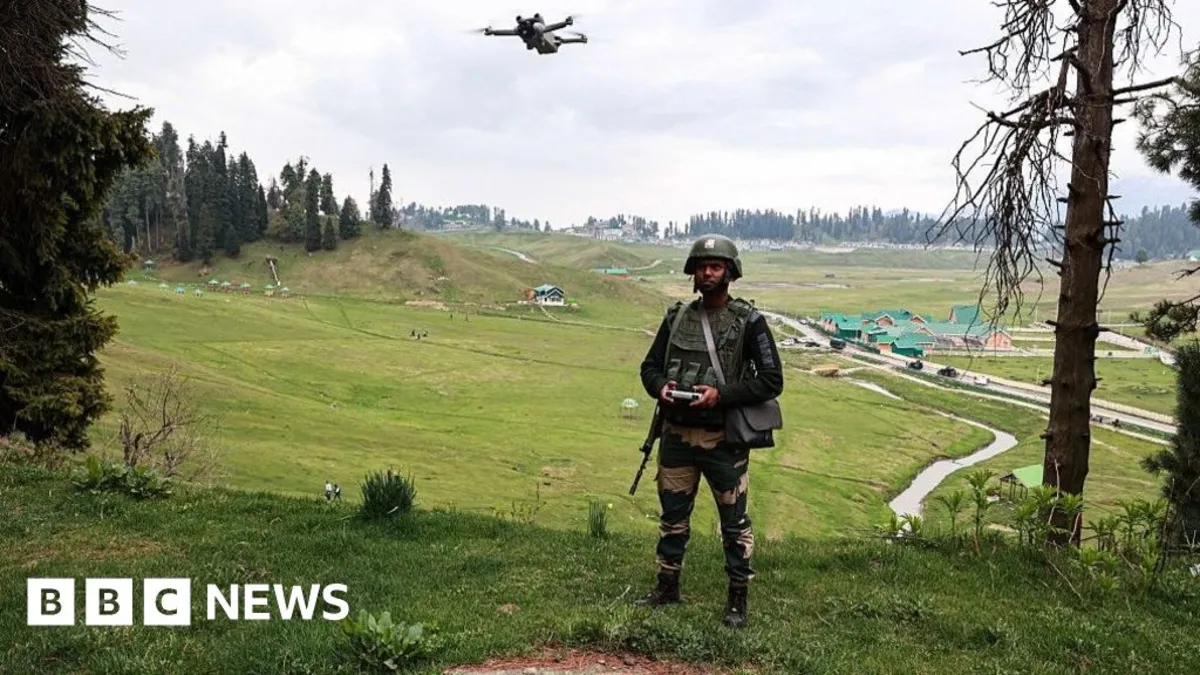
The world is witnessing the first drone war between two nuclear-armed neighbors, India and Pakistan, marking a significant escalation in their long-standing rivalry. On Thursday, India accused Pakistan of launching multiple waves of drones and missiles targeting three military bases within Indian territory and Indian-administered Kashmir. In response, Pakistan denied these allegations, asserting that it successfully shot down 25 Indian drones in recent hours. As tensions rise, experts warn that these tit-for-tat attacks represent a perilous new phase in the ongoing conflict, with unmanned aerial vehicles (UAVs) playing a pivotal role. With global powers like Washington urging both nations to exercise restraint, the region stands on the brink of further escalation, as the use of drones introduces a new dimension to the India-Pakistan conflict.
The Indo-Pak conflict is evolving into a new era characterized by drone warfare, where invisible eyes and precision strikes may dictate the course of military engagement. Jahara Matisek, a professor at the US Naval War College, emphasized that the side that masters drone warfare will not only observe the battlefield but also shape its dynamics. The recent escalation began on Wednesday morning when Pakistan reported that Indian airstrikes and cross-border fire resulted in 36 fatalities and 57 injuries on its soil and in Pakistan-administered Kashmir. Conversely, India's army stated that at least 16 civilians had been killed due to Pakistani shelling. India claims its missile barrage was retaliation for a militant attack on Indian tourists in Pahalgam last month, an incident that Islamabad denies any involvement in.
On Thursday, Pakistan's military announced the successful interception of 25 Indian drones across various cities, including Karachi, Lahore, and Rawalpindi. These drones, reportedly Israeli-made Harop drones, were brought down using a combination of technical and weapon-based countermeasures. India, on the other hand, claims to have neutralized several Pakistani air defense radars and systems, including one located in Lahore, which Pakistan has refuted. The role of drones in modern warfare has become increasingly significant, providing enhanced precision and efficiency in military operations. Drones can relay coordinates for airstrikes or, when equipped appropriately, directly laser-designate targets for immediate engagement. They can also serve as decoys, triggering enemy radar emissions that allow for targeting by other munitions.
Experts suggest that India's drone fleet is primarily comprised of Israeli-made reconnaissance UAVs such as the IAI Searcher and Heron, along with loitering munitions like Harpy and Harop, which function as both drones and missiles capable of autonomous reconnaissance and precision strikes. The Harop drone, in particular, signifies a shift toward high-value, precision-targeted warfare, underscoring the increasing relevance of loitering munitions in contemporary conflicts. The Heron UAV serves as India's high-altitude surveillance asset for both peacetime monitoring and combat operations, while the IAI Searcher Mk II is designed for frontline missions, boasting an endurance of up to 18 hours, a range of 300 km (186 miles), and a service ceiling of 7,000 m (23,000 ft).
Despite perceptions that India's combat drone numbers are relatively modest, a recent $4 billion agreement to acquire 31 MQ-9B Predator drones from the United States represents a substantial enhancement of its strike capabilities. Moreover, India is actively developing swarm drone tactics, which involve deploying large numbers of smaller UAVs to saturate and overwhelm enemy air defenses, facilitating the penetration of higher-value assets.
Pakistan’s drone capabilities are extensive and varied, comprising both domestically produced and imported systems. Ejaz Haider, a defense analyst based in Lahore, indicates that Pakistan's inventory includes over a thousand drones, featuring models from China, Turkey, and local manufacturers. Noteworthy platforms include the Chinese CH-4, the Turkish Bayraktar Akinci, and Pakistan's own Burraq and Shahpar drones. Additionally, Pakistan has developed loitering munitions that augment its strike capabilities. The Pakistan Air Force (PAF) has been integrating unmanned systems into its operations for nearly a decade, focusing on the development of loyal wingman drones designed to operate alongside manned aircraft.
Experts believe that Israel's technical support in supplying Harop and Heron drones has been crucial for India, while Pakistan's dependence on Turkish and Chinese platforms illustrates the ongoing arms race in the region. While the recent drone exchanges between India and Pakistan signify a substantial escalation in their rivalry, they differ significantly from the drone-centric warfare observed in the Russia-Ukraine conflict. In that scenario, drones play a central role in military operations, with both sides deploying thousands of UAVs for a variety of purposes including surveillance, targeting, and direct attacks.
Using drones in the current conflict, as opposed to fighter jets or heavy missiles, represents a more restrained military option. Drones are typically less heavily armed than manned aircraft; however, this could be a precursor to a more extensive aerial campaign, altering the strategic calculus entirely. Manoj Joshi, an Indian defense analyst, points out that a significant retaliatory strike against India would likely involve a more comprehensive strategy, utilizing multiple platforms—both manned and unmanned—to target a broader array of objectives. Such an operation would aim to deliver a decisive impact, signaling a serious escalation beyond the current exchanges.
In conclusion, the first drone war between India and Pakistan is not only reshaping military tactics but also redefining the nature of their conflict. As both countries continue to develop and deploy advanced drone technologies, the stakes are higher than ever, with the potential for significant regional implications.